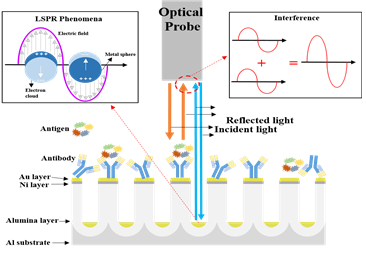글로벌 연구동향
의학물리학
![[Sensors (Basel).] Easy-to-Fabricate and High-Sensitivity LSPR Type Specific Protein Detection Sensor Using AAO Nano-Pore Size Control.](/enewspaper/upimages/admin_20170518161259_R.jpg) [Sensors (Basel).] Easy-to-Fabricate and High-Sensitivity LSPR Type Specific Protein Detection Sensor Using AAO Nano-Pore Size Control.
[Sensors (Basel).] Easy-to-Fabricate and High-Sensitivity LSPR Type Specific Protein Detection Sensor Using AAO Nano-Pore Size Control.경북대/ 김새완, 강신원*
- 출처
- Sensors (Basel).
- 등재일
- 2017 Apr 13
- 저널이슈번호
- 17(4). pii: E856. doi: 10.3390/s17040856.
- 내용

AbstractIn this study, we developed a pore size/pore area-controlled optical biosensor-based anodic aluminum oxide (AAO) nanostructure. As the pore size of AAO increases, the unit cell of AAO increases, which also increases the non-pore area to which the antibody binds. The increase in the number of antibodies immobilized on the surface of the AAO enables effective detection of trace amounts of antigen, because increased antigen-antibody bonding results in a larger surface refractive index change. High sensitivity was thus achieved through amplification of the interference wave of two vertically-incident reflected waves through the localized surface plasmon resonance phenomenon. The sensitivity of the fabricated sensor was evaluated by measuring the change in wavelength with the change in the refractive index of the device surface, and sensitivity was increased with increasing pore-size and non-pore area. The sensitivity of the fabricated sensor was improved and up to 11.8 ag/mL serum amyloid A1 antigen was detected. In addition, the selectivity of the fabricated sensor was confirmed through a reaction with a heterogeneous substance, C-reactive protein antigen. By using hard anodization during fabrication of the AAO, the fabrication time of the device was reduced and the AAO chip was fabricated quickly and easily.
Author information
Kim SW1, Lee JS2, Lee SW3, Kang BH4, Kwon JB5, Kim OS6, Kim JS7, Kim ES8, Kwon DH9, Kang SW10.
1School of Electronics Engineering, College of IT Engineering, Kyungpook National University, 1370 Sankyuk-dong, Bukgu, 702-701 Daegu, Korea. kei95304@gamil.com.2School of Electronics Engineering, College of IT Engineering, Kyungpook National University, 1370 Sankyuk-dong, Bukgu, 702-701 Daegu, Korea. jslee_1245@naver.com.3School of Electronics Engineering, College of IT Engineering, Kyungpook National University, 1370 Sankyuk-dong, Bukgu, 702-701 Daegu, Korea. sw3148@ee.knu.ac.kr.4Division of Advanced Research and Development, SINOKOR, 12 Seongseogongdanbuk-ro 43-gil, Dalseo-gu, Daegu 704-920, Korea. bhkang@ee.knu.ac.kr.5School of Electronics Engineering, College of IT Engineering, Kyungpook National University, 1370 Sankyuk-dong, Bukgu, 702-701 Daegu, Korea. jinbumkwon@naver.com.6School of Electronics Engineering, College of IT Engineering, Kyungpook National University, 1370 Sankyuk-dong, Bukgu, 702-701 Daegu, Korea. oskim@knu.ac.kr.7School of Electronics Engineering, College of IT Engineering, Kyungpook National University, 1370 Sankyuk-dong, Bukgu, 702-701 Daegu, Korea. jskim5772@ee.knu.ac.kr.8Division of Computer and Electronic Engineering, Pusan University of Foreign studies, 65 Namsan-dong, Geumjeong-gu, 608-738 Busan, Korea. eskim@pufs.ac.kr.9Department of Electronics Engineering, Kyungil University, Hayang-up, Gyeongsang buk-do 712-702, Korea. dhkwon@kiu.ac.kr.10School of Electronics Engineering, College of IT Engineering, Kyungpook National University, 1370 Sankyuk-dong, Bukgu, 702-701 Daegu, Korea. swkang@knu.ac.kr.
- 키워드
- C-reactive protein (CRP); anodic aluminum oxide (AAO); localized surface plasmon resonance (LSPR); optical interferometry; optical-biosensor; pore-area; pore-size; serum amyloid A1 (SAA1)
- 연구소개
- 최근 나노스케일의 알루미늄 산화막에서 나타나는 특이적인 국소표면플라즈몬공명 현상을 이용한 바이오 센서에 관한 논문입니다. 이는 알루미늄을 양극 산화하게 되면 나노 스케일의 기공이 형성되는데, 이는 산화 조건에(전해질 용액, 전압, 시간 등)에 따라 다른 크기와 두께를 가지게 됩니다. 이러한 기공의 형성 조건을 제어하여 소자의 표면적을 최적화 하였습니다. 이를 통해 표면에 결합 가능한 항체의 수를 증가시켜 표적 항원에 대한 감도를 극대화하였고, 10 ag/ml의 항원을 검출할 수 있는 고감도 센서에 관한 연구입니다.
- 덧글달기









